Written Records, AWM54 741/5/9 PART 2 - [Patrols - Reconnaissance:] Report on Northern Territory Special Reconnaissance Unit, by Sqn Ldr D F Thomson RAAF [Report minus maps] - Part 6
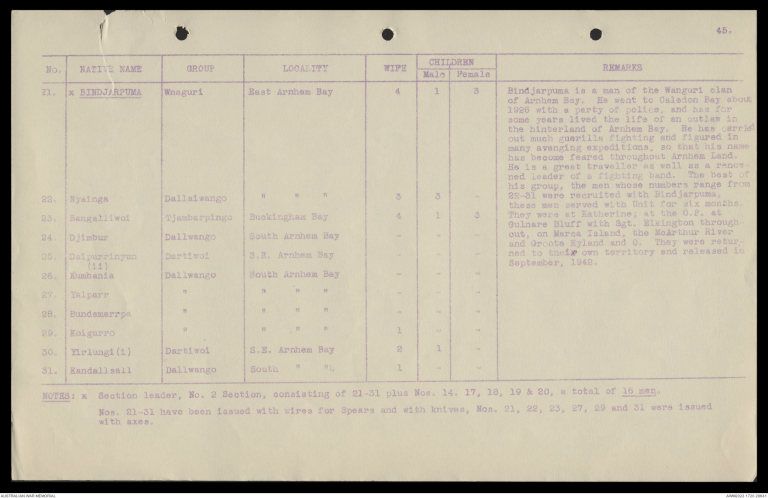
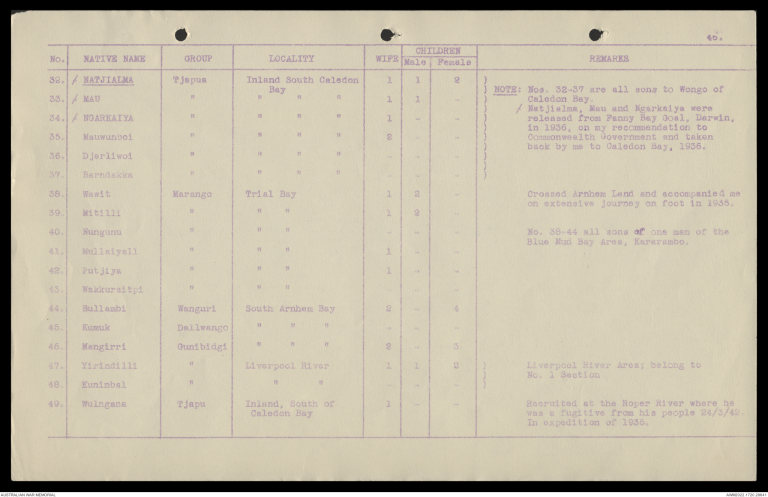
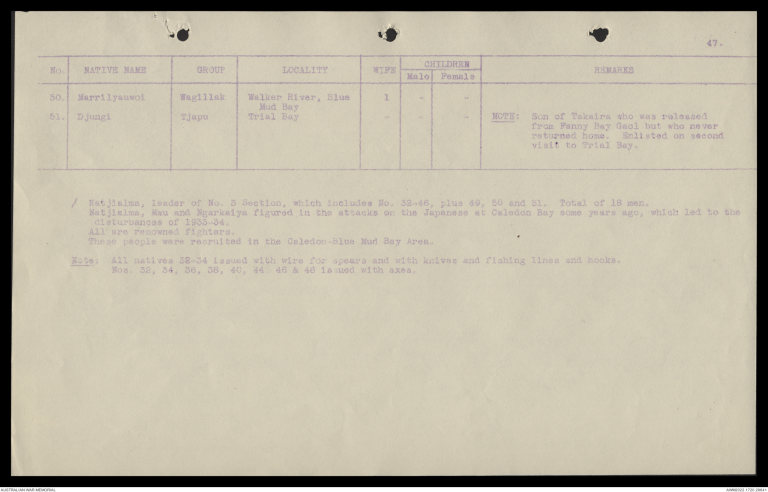
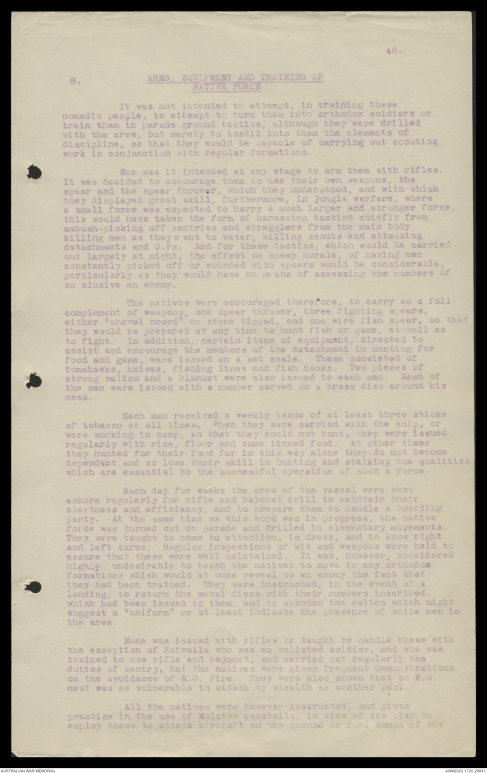
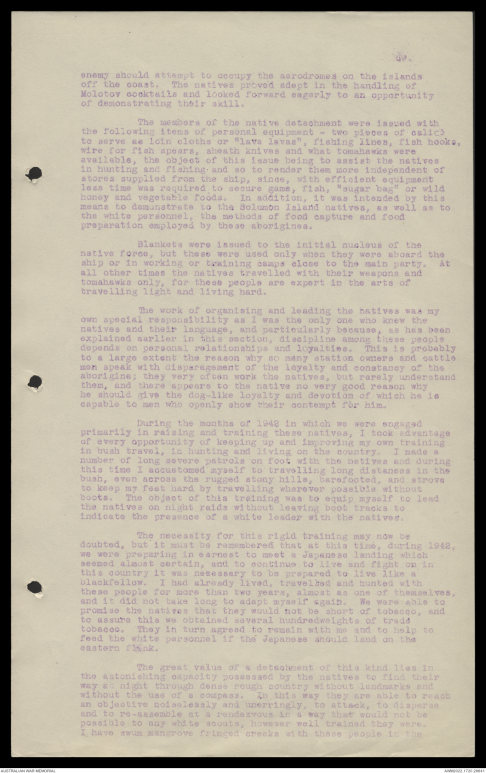
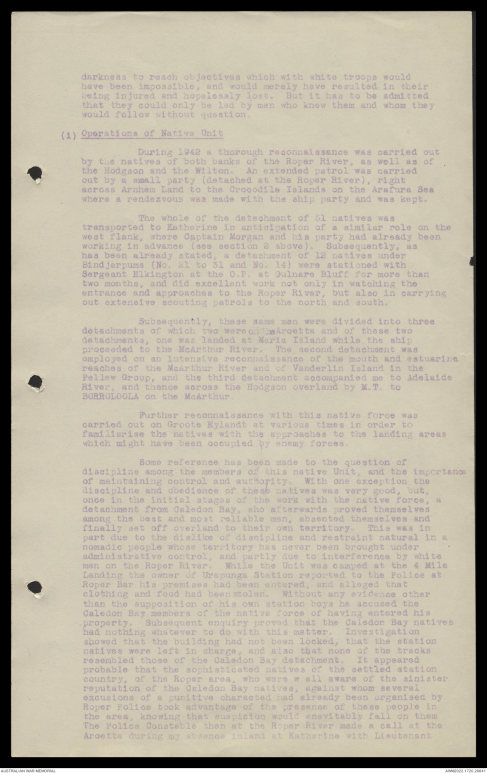
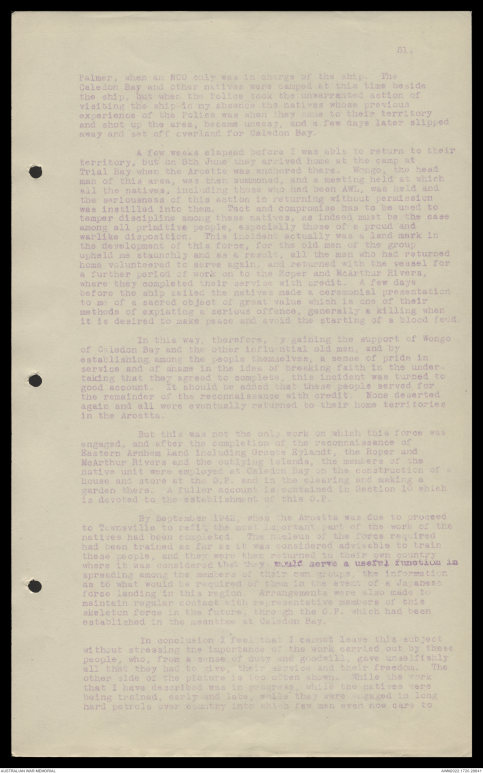
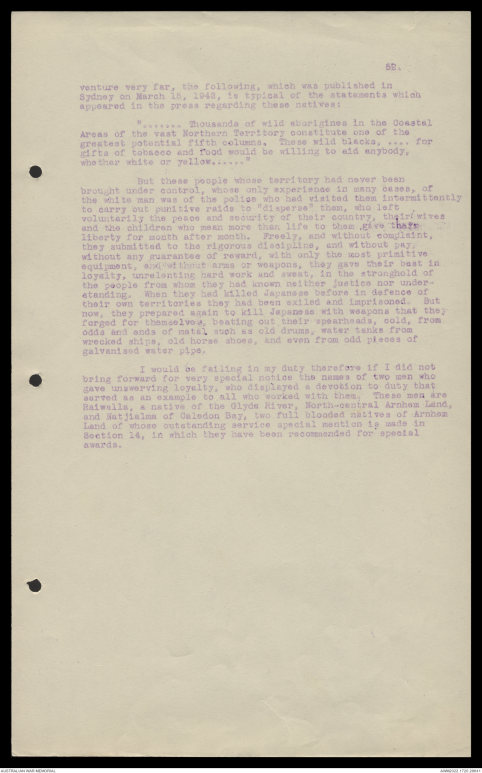
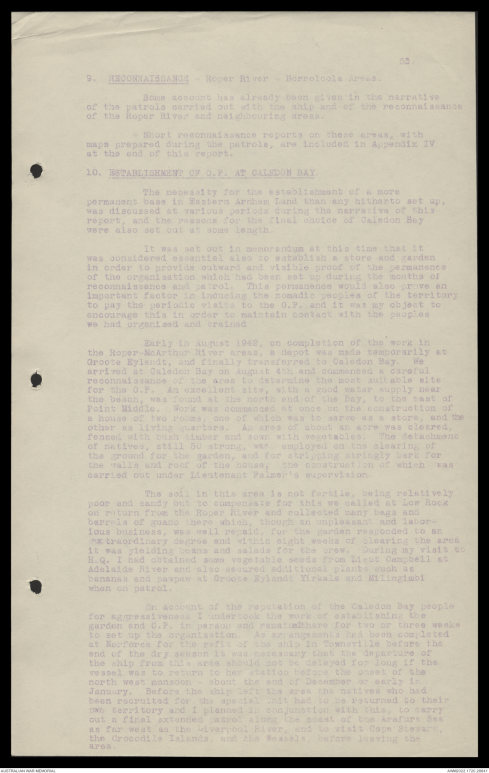
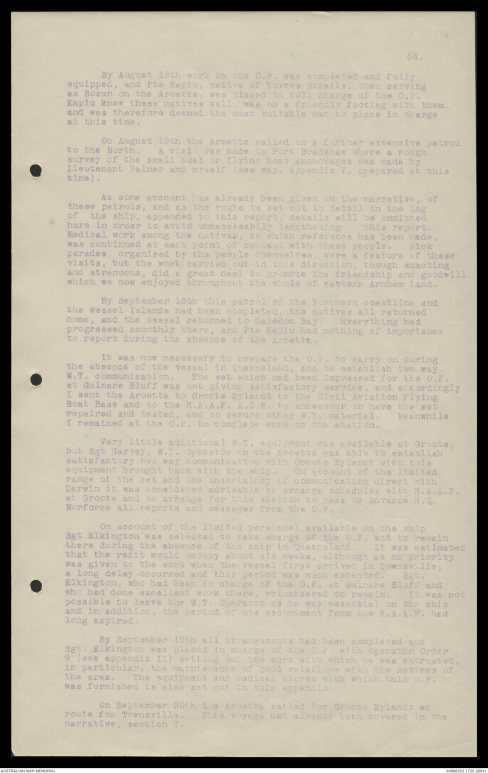
45.
|
No. |
NATIVE NAME |
GROUP |
LOCALITY |
WIFE |
CHILDREN |
REMARKS |
|
| Male | Female | ||||||
| 21. | X BINDJARPUMAN | Wnaguri | East Arnhem Bay |
4 |
1 |
3 |
Bindjarpuma is a man of the Wanguri clan of Arnhem Bay. He went to Caledon Bay about 1926 with a party of police, and has for some years lived the life of an outlaw in the hinterland of Arnhem Bay. He has carried out much guerilla fighting and figured in many avenging expeditions, so that his name has become feared throughout Arnhem Land. He is a great traveller as well as a renowned leader of a fighting band. The best of his group, the men whose numbers range from 28-31 were recruited with Binjarpuma, these men served with Unit for six months. They were at Katherine; at the O.P. at Gulnare Bluff with Sgt. Elkington through out, on Marca Island, the McArthur River and Groote Eyland and Q. They were returned to their own territory and released in September, 1942. |
| 22. | Nyalnga |
Dallaiwango |
" " " |
3 |
3 |
- |
|
| 23. | Bangalilwoi | Tjambarpingo | Buckingham Bay |
4 |
3 |
1 |
|
| 24. | Djimbur | Dallwango | South Arnhem Bay |
- |
- |
- |
|
| 25. | Dalpurrinyun (ii) |
Dartiwoi | S.E. Arnhem Bay |
- |
- |
- |
|
| 26. | Kumbania | Dallwango | South Arnhem Bay |
- |
- |
- |
|
| 27. | Yalpurr | " |
" " " |
- |
- |
- |
|
| 28. | Bundamarrpa | " |
" " " |
- |
- |
- |
|
| 29. | Koigurro | " |
" " " |
1 |
|
- |
|
| 30. | Yirlungi (i) | Dartiwoi | S.E. Arnhem Bay |
2 |
1 |
- |
|
| 31. | Kandallsall | Dallwango |
South " " |
1 |
|
- |
|
NOTES: X Section leader, No. 2 Section, consisting of 21-31 plus Nos. 14, 17, 18, 19 & 20, a total of 16 men.
Nos. 21-31 have been issued with wires for Spears and with knives, Nos. 21, 22, 23, 27, 29 and 31 were issued
with axes.
46.
|
No. |
NATIVE NAME |
GROUP |
LOCALITY |
WIFE |
CHILDREN |
|
REMARKS |
|
| Male | Female | |||||||
| 32. | /NATJIALMA | Tjapus | Inland South Caledon Bay |
1 |
1 |
2 |
) | NOTE: Nos. 32-37 are all sons to Wongo of Caledon Bay. /Natjialma, Mau and Ngarkaiya were released from Fanny Bay Goal, Darwin, in 1936, on my recommendation to Commonwealth Government and taken back by me to Caledon Bay, 1936. |
| 33. | /MAU | " | " " " |
1 |
1 |
- |
) | |
| 34. | /NGARKAIYA | " | " " " |
1 |
- |
- |
) | |
| 35. | MAUWUNPOI | " | " " " |
2 |
- |
- |
) | |
| 36. | Djerliwoi | " | " " " |
- |
- |
- |
) | |
| 37. | Barndakka | " | " " " |
- |
- |
- |
) | |
| 38. | Wawit | Marango | Trial Bay |
1 |
2 |
- |
Crossed Arnhem Land and accompanied me on extensive journey on foot in 1935. | |
| 39. | Mitilli | " | " " |
1 |
2 |
- |
||
| 40. | Nungunu | " | " " |
- |
- |
- |
No. 38-44 all sons of one man of the Blue Mud Bay Area, Kararambo. | |
| 41. | Mullaiyall | " | " " |
1 |
- |
- |
||
| 42. | Putjiya | " | " " |
1 |
- |
- |
||
| 43. | Wakkuraitpi | " | " " |
- |
- |
- |
||
| 44. | Bullambi | Wanguri | South Arnhem Bay |
2 |
- |
4 |
||
| 45. | Kumuk | Dallwango | " " " |
- |
- |
- |
||
| 46. | Mangirri | Gunibidgi | " " " |
2 |
- |
3 |
||
| 47. | Yirindilli | " | Liverpool River |
1 |
1 |
2 |
Liverpool River Area; | |
| 48. | Kuninbal | " | " " |
- |
- |
- |
belong to No. 1 Section | |
| 49. | Walagana | Tjapu | Inland, South of Caledon Bay |
1 |
- |
- |
Recruited at the Roper River where he was a fugitive from his people 24/3/42. In expedition of 1936. | |
47.
|
|
|
|
|
|
CHILDREN |
|
|
|
No. |
NATIVE NAME |
GROUP |
LOCALITY |
WIFE |
Male |
Female |
REMARKS |
| 50. | Narrilyauwoi | Wagillak | Walker River, Blue Mud Bay |
1 |
- |
- |
|
| 51. | Djungi | Tjapu | Trial Bay |
- |
- |
- |
NOTE: Son of Takaira who was released from Fanny Bay Gaol but who never returned home. Enlisted on second visit to Trial Bay. |
/ Natjialma, leader of No. 5 Section, which includes No. 32-46, plus 49, 50 and 51. Total of 18 men.
Natjialma, Mau and Ngarkaiyu figured in the attacks on the Japanese at Caledon Bay some years ago, which led to the
disturbances of 1933-34.
All are renowned fighters.
These people were recruited in the Caledon - Blue Mud Bay Area.
Note: All natives 32-34 issued with wire for spears and with knives and fishing lines and hooks.
Nos. 32, 34, 36, 38, 40, 44, 46 & 48 issued with axes.
48.
8. ARMS, EQUIPMENT AND TRAINING OF
NATIVE FORCE
It was not intended to attempt, in training these
nomadic people, to attempt to turn them into orthodox soldiers or
train them in parade ground tactics, although they were drilled
with the crew, but merely to instil into them the elements of
discipline, so that they would be capable of carrying out scouting
work in conjunction with regular formations.
Nor was it intended at any stage to arm them with rifles.
It was decided to encourage them to use their own weapons, the
spear and the spear thrower, which they understood, and with which
they displayed great skill, furthermore, in jungle warfare, where
a small force was expected to harry a much larger and stronger force,
this would have taken the form of harassing tactics chiefly from
ambush-picking off sentries and stragglers from the main body
killing men as they went to water, killing scouts and attacking
detachments and O.Ps. And for these tactics, which would be carried
out largely at night, the effect on enemy morale, of having men
constantly picked off or wounded with spears would be considerable,
particularly as they would have no means of assessing the numbers of
so elusive an enemy.
The natives were encouraged therefore, to carry as a full
complement of weapons, one spear thrower, three fighting spears,
either "shovel nosed" or stone tipped, and one wire fish spear, so that
they would be prepared at any time to hunt fish or game, as well as
to fight. In addition, certain items of equipment, directed to
assist and encourage the members of the detachment in hunting for
food and game, were issued on a set scale. These consisted of
tomahawks, knives, fishing lines and fish hooks. Two pieces of
strong calico and a blanket were also issued to each man. Each of
the men were issued with a number carved on a brass disc around his
neck.
Each man received a weekly issue of at least three sticks
of tobacco at all times. When they were carried with the ship, or
were working in camp, so that they could not hunt, they were issued
regularly with rice, flour and some tinned food. At other times
they hunted for their food for in this way alone they do not become
dependent and so lose their skill in hunting and stalking the qualities
which are essential to the successful operation of such a force.
Each day for weeks the crew of the vessel were sent
ashore regularly for rifle and bayonet drill to maintain their
alertness and efficiency and to prepare them to handle a boarding
party. At the same time as this work was in progress, the native
force was turned out on parade and drilled in elementary movements.
They were taught to come to attention, to dress, and to know right
and left turns. Regular inspections of kit and weapons were held to
assure that these were well maintained. It was, however, considered
highly undesirable to teach the native to move in any orthodox
formations which would at once reveal to an enemy the fact that
they had been trained. They were instructed, in the event of a
landing, to return the metal discs with their numbers inscribed,
which had been issued to them and to abandon the calico which might
suggest a "uniform" or at least indicate the presence of white men in
the area.
None was issued with rifles or taught to handle these with
the exception of Raiwalla who was an enlisted soldier, and who was
trained to use rifle and bayonet, and carried out regularly the
duties of sentry, but the natives were given frequent demonstrations
on the avoidance of M.G. fire. They were also shown that an M.G.
nest was as vulnerable to attack by stealth as another post.
All the natives were however instructed, and given
practice in the use of Molotov cocktails, in view of the plan to
employ these to attack aircraft on the ground or fuel dumps if the
49.
enemy should attempt to occupy the aerodromes on the islands
off the coast. The natives proved adept in the handling of
Molotov cocktails and looked forward eagerly to an opportunity
of demonstrating their skill.
The members of the native detachment were issued with
the following items of personal equipment - two pieces of calico
to serve as loin cloths or "lava lavas", fishing lines, fish hooks,
wire for fish spears, sheath knives and what tomahawks were
available, the object of this issue being to assist the natives
in hunting and fishing and so to render them more independent of
stores supplied from the ship, since, with efficient equipment
less time was required to secure game, fish, "sugar bag" or wild
honey and vegetable foods. In addition, it was intended by this
means to demonstrate to the Solomon Island natives, as well as to
the white personnel, the methods of food capture and food
preparation employed by these aborigines.
Blankets were issued to the initial nucleus of the
native force, but these were only used when they were aboard the
ship or in working or training camps close to the main party. At
all other times the natives travelled with their weapons and
tomahawks only, for these people are expert in the arts of
travelling light and living hard.
The work of organising and leading the natives was my
own special responsibility as I was the only one who knew the
natives and their language, and particularly because, as has been
explained earlier in this section, discipline among these people
depends on personal relationships and loyalties. This is probably
to a large extent the reason why so many station owners and cattle
men speak with disparagement of the loyalty and constancy of the
aborigines; they very often work the natives, but rarely understand
them, and there appears to the native no very good reason why
he should give the dog-like loyalty and devotion of which he is
capable to men who openly show their contempt for him.
During the months of 1942 in which we were engaged
primarily in raising and training these natives, I took advantage
of every opportunity of keeping up and improving my own training
in bush travel, in hunting and living on the country. I made a
number of long severe patrols on foot with the natives and during
this time I accustomed myself to travelling long distances in the
bush, even across the rugged stony hills, barefooted, and strove
to keep my feet hard by travelling wherever possible without
boots. The object of this training was to equip myself to lead
the natives on night raids without leaving boot tracks to
indicate the presence of a white leader with the natives.
The necessity for this rigid training may now be
doubted, but it must be remembered that at this time, during 1942,
we were preparing in earnest to meet a Japanese landing which
seemed almost certain, and to continue to live and fight on in
this country it was necessary to be prepared to live like a
blackfellow. I had already lived, travelled and hunted with
these people for more than two years, almost as one of themselves,
and it did not take long to adapt myself again. We were able to
promise the natives that they would not be short of tobacco, and
to assure this we obtained several hundred weights of trade
tobacco. They in turn agreed to remain with me and to help to
feed the white personnel if the Japanese should land on the
eastern flank.
The great value of a detachment of this kind lies in
the astonishing capacity possessed by the natives to find their
way at night through dense, rough country without landmarks and
without the use of a compass. In this way they are able to reach
an objective noiselessly and unerringly, to attack, to disperse
and to re-assemble at a rendezvous in a way that would not be
possible to any white scouts, however well trained they were.
I have swum mangrove fringed creeks with these people in the
darkness to reach objectives which with white troops would
have been impossible, and would merely have resulted in their
being injured and hopelessly lost. But it has to be admitted
that they could only be led by men who know them and whom they
would follow without question.
(i) Operations of Native Unit
During 1942 a thorough reconnaissance was carried out
by the natives of both banks of the Roper River, as well as of
the Hodgson and the Wilton. An extended patrol was carried
out by a small party (detached at the Roper River), right
across Arnhem Land to the Crocodile Islands on the Arafura Sea
where a rendezvous was made with the ship party and was kept.
The whole of the detachment of 51 natives was
transported to Katherine in anticipation of a similar role on the
west flank, where Captain Morgan and his party had already been
working in advance (see section 2 above). Subsequently, as
has been already stated, a detachment of 12 natives under
Binjarpuma (No. 21 to 31 and No. 14) were stationed with
Sergeant Elkington at the O.P. at Gulnare Bluff for more than
two months, and did excellent work not only in watching the
entrance and approaches to the Roper River, but also in carrying
out extensive scouting patrols to the north and south.
Subsequently, these same men were divided into three
detachments of which two were on Aroetta and of these two
detachments, one was landed at Maria Island while the ship
proceeded to the McArthur River. The second detachment was
employed on an intensive reconnaissance of the mouth and estuarine
reaches of the McArthur River and of Vanderlin Island in the
Fellow Group, and the third detachment accompanied me to Adelaide
River, and thence across the Hodgson overland by M.T. to
BORROLOOLA on the McArthur.
Further reconnaissance with this native force was
carried out on Groote Eylandt at various times in order to
familiarise the natives with the approaches to the landing areas
which might have been occupied by enemy forces.
Some reference has been made to the question of
discipline among the members of this native Unit, and the importance
of maintaining control and authority. With one exception the
discipline and obedience of these natives was very good, but,
once in the initial stages of the work with the native force, a
detachment from Caledon Bay, who afterwards proved themselves
among the best and most reliable men, absented themselves and
finally set off overland to their own territory. This was in
part due to the dislike of discipline and restraint natural in a
nomadic people whose territory has never been brought under
administrative control, and partly due to interference by white
men on the Roper River. While the Unit was camped at the 4 Mile
Landing the owner of Urapunga Station reported to the Police at
Roper Bar his premises had been entered, and alleged that
clothing and food had been stolen. Without any evidence other
than the supposition of his own station boys he accused the
Caledon Bay members of the Native Force of having entered his
property. Subsequent enquiry proved that the Caledon Bay natives
had nothing whatever to do with this matter. Investigation
showed that the building had not been locked, that the station
natives were left in charge, and also that none of the tracks
resembled those of the Caledon Bay detachment. It appeared
probable that the sophisticated natives of the settled station
country, of the Roper area, who were all aware of the sinister
reputation of the Caledon Bay natives, against whom several
excusions of a punitive character and already been organised by
Roper Police took advantage of the presence of these people in
the area, knowing that suspicion would inevitably fall on them
The Police Constable then at the Roper River made a call at the
Aroetta during my absence inland at Katherine with Lieutenant
51.
Palmer, when an NCO only was in charge of the ship. The
Caledon Bay and other natives were camped at this time beside
the ship, but when the Police took the unwarranted action of
visiting the ship in my absence the natives whose previous
experience of the Police was when they came to their territory
and shot up the area, became uneasy and a few days later slipped
away and set off overland for Caledon Bay.
A few weeks elapsed before I was able to return to their
territory, but on 6th June they arrived home at the camp at
Trial Bay when the Aroetta was anchored there. Wongo, the head
man of this area, was then summoned, and a meeting held at which
all the natives, including those who had been AWL, was held and
the seriousness of this action in returning without permission
was instilled into them. Tact and compromise has to be used to
temper discipline among these natives, as indeed must be the case
among all primitive people, especially those of a proud and
warlike disposition. This incident actually was a land mark in
the development of this force, for the old man of the group
upheld me staunchly and as a result, all the men who had returned
home volunteered to serve again, and returned with the vessel for
a further period of work on to the Roper and McArthur Rivers,
where they completed their service with credit. A few days
before the ship sailed the natives made a ceremonial presentation
to me of a sacred object of great value which is one of their
methods of expiating a serious offence, generally a killing when
it is desired to make peace and avoid the starting of a blood feud.
In this way, therefore, gaining the support of Wongo
of Caledon Bay and the other influential old men and by
establishing among the people themselves, a sense of pride in
service and of shame in the idea of breaking faith is the undertaking
that they agreed to complete, this incident was turned to
good account. It should be added that these people served for
the remainder of the reconnaissance with credit. None deserted
again and all were eventually returned to their home territories
in the Aroetta.
But this was not the only work on which this force was
engaged, and after the completion of the reconnaissance of
Eastern Arnhem Land including Groote Eylandt, the Roper and
McArthur Rivers and the outlying islands, the members of the
native unit were employed at Caledon Bay on the construction of a
house and store at the O.P. and in the clearing and making a
garden there. A fuller account is contained in Section 10 which
is devoted to the establishment of this O.P.
By September 1942, as the Aroetta was due to proceed
to Townsville to refit, the most important part of the work of the
natives had been completed. The nucleus of the force required
had been trained as far as it was considered advisable to train
these people, and they were then returned to their own country
where it was considered that they would serve a useful function in
spreading among the members of their own groups, the information
as to what would be required of them in the event of a Japanese
force landing in this region. Arrangements were also made to
maintain regular contact with representative members of this
skeleton force in the future, through the O.P. which had been
established in the meantime at Caledon Bay.
In conclusion I feel that I cannot leave this subject
without stressing the importance of the work carried out by these
people, who, from a sense of duty and goodwill, gave unselfishly
all that they had to give, their service and their freedom. The
other side of the picture is too often shown. While the work
that I have described was in progress, while the natives were
being trained, early and late, while they were engaged in long
hard patrols over country into which few men even now care to
52.
venture very far, the following, which was published in
Sydney on March 15, 1942, is typical of the statements which
appeared in the press regarding these natives:
"...... Thousands of wild aborigines in the Coastal
Areas of the vast Northern Territory constitute one of the
greatest potential fifth columns. These wild blacks,..... for
gifts of tobacco and food would be willing to aid anybody,
whether white or yellow ....."
But these people whose territory had never been
brought under control, whose only experience in many cases, of
the white man was of the police who had visited them intermittently
to carry out punitive raids to "disperse" them, who left
voluntarily the peace and security of their country, their wives
and the children who mean more than life to them, give their
liberty for month after month. Freely, and without complaint,
they submitted to the rigorous discipline, and without pay,
without any guarantee of reward, with only the most primitive
equipment, and without arms or weapons, they gave their best in
loyalty, unrelenting hard work and sweat, in the stronghold of
the people from whom they had known neither justice nor under-
standing. When they had killed Japanese before in defence of
their own territories they had been exiled and imprisoned. But
now, they prepared again to kill Japanese with weapons that they
forged for themselves, beating out their spearheads, cold , from
odds and ends of metal, such as old drums, water tanks from
wrecked ships, old horse shoes, and even from odd pieces of
galvanised water pipe.
I would be failing in my duty therefore if I did not
bring forward for very special notice the names of two men who
gave unswerving loyalty, who displayed a devotion to duty that
served as an example to all who worked with the. These men are
Raiwalla, a native of Glyde River, North-central Arnhem Land,
and Natjialma of Caledon Bay, two full blooded natives of Arnhem
Land of whose outstanding service special mention is made in
Section 14, in which they have been recommended for special
awards.
53.
9. RECONNAISSANCE - Roper River - Borroloola Areas.
Some account has already been given in the narrative
of the patrols carried out with the ship and of the reconnaissance
of the Roper River and neighbouring areas.
Short reconnaissance reports on these areas, with
maps prepared during the patrols, are included in Appendix IV
at the end of this report.
10. ESTABLISHMENT OF O.P. AT CALEDON BAY
The necessity for the establishment of a more
permanent base in Eastern Arnhem Land than any hitherto set up,
was discussed at various periods during the narrative of this
report, and the reasons for the final choice of Caledon Bay
were also set out at some length.
It was set out in memorandum at this time that it
was considered essential also to establish a store and garden
in order to provide outward and visible proof of the permanence
of the organisation which had been set up during the months of
reconnaissance and patrol. This permanence would also prove an
important factor in inducing the nomadic peoples of the territory
to pay the periodic visits to the O.P. and it was my object to
encourage this in order to maintain contact with the peoples
we had organised and trained.
Early in August 1942, on completion of the work in
the Roper-McArthur River areas, a depot was made temporarily at
Groote Eylandt, and finally transferred to Caledon Bay. We
arrived at Caledon Bay on August 4th and commenced a careful
reconnaissance of the area to determine the most suitable site
for this O.P. An excellent site, with a good water supply near
the beach, was found at the north end of the bay, to the east of
Point Middle. Work was commenced at once in the construction of
a house of two rooms, one of which was to serve as a store, and the
other as living quarters. An area of about an acre was cleared,
fenced, with bush timber and sown with vegetables. The detachment
of natives, still 50 strong, was employed on the clearing of
the ground for the garden, and for stripping stringy bark for
the walls and roof of the house, the construction of which was
carried out under Lieutenant Palmer's supervision.
The soil in this area is not fertile, being relatively
poor and sandy but to compensate for this we called at Low Rock
on return from the Roper River and collected many bags and
barrels of guano there which, though an unpleasant and laborious
business, was well repaid for the garden responded to an
extraordinary degree and within eight weeks of clearing the area
it was yielding beans and salads for the crew. During my visit to
H.Q. I had obtained some vegetable seeds from Lieut Campbell at
Adelaide River and also secured additional plants such as
bananas and pawpaw at Groote Eylandt, Yirkala and Milingimbi
when on patrol.
On account of the reputation of the Caledon Bay people
for aggressiveness I undertook the work of establishing the
garden and O.P. in person and remained there for two or three weeks
to set up the organisation. An arrangement had been completed
at Norforce for the refit of the ship in Townsville before the
end of the dry season it was necessary that the departure of
the ship from this area should not be delayed for long if the
vessel was to return to her station before the onset of the
north west monsoon - about the end of December or early in
January. Before the ship left the area the natives who had
been recruited for the special unit had to be returned to their
own territory and I planned in conjunction with this, to carry
out a final extended patrol along the coast of the Arafura Sea
as far west as the Liverpool River and to visit Cape Stewart,
the Crocodile Islands and the Wessels before leaving the
area.
54.
By August 18th work on the O.P. was completed and fully
equipped, and Pte Kapiu, native of Torres Straits, then serving
as Bosun on the Aroetta, was placed in full charge of the O.P.
Kapiu knew these natives well, was on a friendly footing with them
and was therefore deemed the most suitable man to place in charge
at this time.
On August 19th the Aroetta sailed on a further extensive patrol
to the North. A visit was made to Fort Bradshaw where a rough
survey of the small boat or flying boat anchorages was made by
Lieutenant Palmer and myself (see map, appendix V, prepared at this
time).
As some account has already been given in the narrative, of
these patrols, and as the route is set out in detail in the Log
of the ship, appended to this report, details will be committed
here in order to avoid unnecessarily lengthening this report.
Medical work among the natives, to which reference has been made,
was continued at each point of contact with these people. Sick
parades organised by the people themselves were a feature of these
visits, but the work carried out in this direction, though exacting
and strenuous, did a great deal to promote the friendship and goodwill
which we now enjoyed throughout the whole of eastern Arnhem Land.
By September 13th this patrol of the Northern coastline and
the Wessel Islands had been completed, the natives all returned
home, and the vessel returned to Caledon Bay. Everything had
progressed smoothly there, and Pte Kapiu had nothing of importance
to report during the absence of the Aroetta.
It was now necessary to prepare the O.P. to carry on during
the absence of the vessel in Queensland, and to establish two way
W.T. communication. The set which had been impressed for the O.P.
at Gulnare Bluff was not giving satisfactory service, and accordingly
I sent the Aroetta to Groote Eylandt to the Civil Aviation Flying
Boat Base and to the R.A.A.F. A.O.B. to endeavour to have the set
repaired and tested, and to secure other W.T. material. Meanwhile
I remained at the O.P. to complete work at the station.
Very little additional W.T. equipment was available at Groote,
but Sgt Harvey, W.T. Operator on the Aroetta was able to establish
satisfactory two way communication with Groote Eylandt with this
equipment brought back with the ship. On account of the limited
range of the set and the uncertainty of communication direct with
Darwin it was considered advisable to arrange schedules with R.A.A.F.
at Groote and to arrange for this station to pass to Advance H.Q.
Norforce all reports and messages from the O.P.
On account of the limited personnel available on the ship
Sgt Elkington was selected to take charge of the O.P. and to remain
there during the absence of the ship in Queensland. It was estimated
that the refit would occupy about six weeks, although as no priority
was given to the work when the vessel first arrived in Townsville,
a long delay occurred and this period was much extended. Sgt.
Elkington who had been in charge of the O.P. at Gulnare Bluff and
who had done excellent work there volunteered to remain. It was not
possible to leave the W.T. Operator as he was essential on the ship
and in addition, the period of his secondment from the R.A.A.F had
long expired.
By September 15th all arrangements had been completed and
Sgt. Elkington was placed in charge of the O.P. with Operation Order
9 (see appendix II) setting out the work with which he was entrusted,
in particular, the maintenance and of good relations with the natives of
the area. The equipment and medical stores with which this O.P.
was furnished is also set out in this appendix.
On September 20th the Aroetta sailed for Groote Eylandt en
route for Townsville. This voyage had already been covered in the
narrative, section T.
 Deb Parkinson
Deb ParkinsonThis transcription item is now locked to you for editing. To release the lock either Save your changes or Cancel.
This lock will be automatically released after 60 minutes of inactivity.